Bible
The Bible (from Koine Greek τὰ βιβλία, tà biblía, "the books")[1][lower-alpha 1] is a collection of religious texts or scriptures sacred to Christians, Jews, Samaritans, Rastafari and others. They generally consider the Bible to be a product of divine inspiration and a record of the relationship between God and humans. The Bible appears in the form of an anthology, a compilation of texts of a variety of forms that are all linked by the belief that they collectively contain the word of God. These texts include theologically-focused historical accounts, hymns, parables, didactic letters, erotica, sermons, poetry, and prophecies.

| Part of a series on the |
| Bible |
|---|
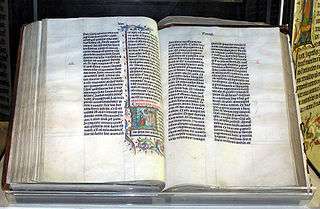 |
|
Perspectives |
|
Outline of Bible-related topics |
Those books included in the Bible by a tradition or group are called canonical, indicating that the tradition/group views the collection as the true representation of God's word and will. A number of Biblical canons have evolved, with overlapping and diverging contents from denomination to denomination.[2] The Hebrew Bible overlaps with the Greek Septuagint and the Christian Old Testament. The Christian New Testament is a collection of writings by early Christians, believed to be mostly Jewish disciples of Christ, written in first-century Koine Greek. Among Christian denominations there is some disagreement about what should be included in the canon, primarily about the biblical apocrypha, a list of works that are regarded with varying levels of respect.
Attitudes towards the Bible also differ among Christian groups. Roman Catholics, high church Anglicans, Methodists and Eastern Orthodox Christians stress the harmony and importance of both the Bible and sacred tradition,[3][4] while many Protestant churches focus on the idea of sola scriptura, or scripture alone. This concept rose to prominence during the Reformation, and many denominations today support the use of the Bible as the only infallible source of Christian teaching. Others though, advance the concept of prima scriptura in contrast.[3]
The Bible has had a massive influence on literature and history, especially in the Western world, where the Gutenberg Bible was the first book printed using movable type.[5][6] According to the March 2007 edition of Time, the Bible "has done more to shape literature, history, entertainment, and culture than any book ever written. Its influence on world history is unparalleled, and shows no signs of abating."[5] With estimated total sales of over 5 billion copies, it is widely considered to be the best-selling book of all time.[5][7][8] As of the 2000s, it sells approximately 100 million copies annually.[9][10]
Etymology
The word βιβλίον itself had the literal meaning of "paper" or "scroll" and came to be used as the ordinary word for "book". It is the diminutive of βύβλος byblos, "Egyptian papyrus", possibly so called from the name of the Phoenician sea port Byblos (also known as Gebal) from whence Egyptian papyrus was exported to Greece.
The Greek ta biblia (lit. "little papyrus books")[11] was "an expression Hellenistic Jews used to describe their sacred books" (the Septuagint).[12][13] Christian use of the term can be traced to c. 223 CE. The biblical scholar F.F. Bruce notes that Chrysostom appears to be the first writer (in his Homilies on Matthew, delivered between 386 and 388) to use the Greek phrase ta biblia ("the books") to describe both the Old and New Testaments together.[14]
Medieval Latin biblia is short for biblia sacra "holy book", while biblia in Greek and Late Latin is neuter plural (gen. bibliorum). It gradually came to be regarded as a feminine singular noun (biblia, gen. bibliae) in medieval Latin, and so the word was loaned as singular into the vernaculars of Western Europe.[15] Latin biblia sacra "holy books" translates Greek τὰ βιβλία τὰ ἅγια tà biblía tà hágia, "the holy books".[16]
The English word Bible is from the Latin biblia, from the same word in Medieval Latin and Late Latin and ultimately from Koinē Greek: τὰ βιβλία, romanized: ta biblia "the books" (singular βιβλίον, biblion).
Textual history
By the 2nd century BCE, Jewish groups began calling the books of the Bible the "scriptures" and they referred to them as "holy", or in Hebrew כִּתְבֵי הַקֹּדֶשׁ (Kitvei hakkodesh), and Christians now commonly call the Old and New Testaments of the Christian Bible "The Holy Bible" (in Greek τὰ βιβλία τὰ ἅγια, tà biblía tà ágia) or "the Holy Scriptures" (η Αγία Γραφή, e Agía Graphḗ).[17] The Bible was divided into chapters in the 13th century by Stephen Langton and into verses in the 16th century by French printer Robert Estienne[18] and is now usually cited by book, chapter, and verse. The division of the Hebrew Bible into verses is based on the sof passuk cantillation mark used by the 10th-century Masoretes to record the verse divisions used in earlier oral traditions.
The oldest extant copy of a complete Bible is an early 4th-century parchment book preserved in the Vatican Library, and it is known as the Codex Vaticanus. The oldest copy of the Tanakh in Hebrew and Aramaic dates from the 10th century CE. The oldest copy of a complete Latin (Vulgate) Bible is the Codex Amiatinus, dating from the 8th century.[19]
Development

Professor John K. Riches, Professor of Divinity and Biblical Criticism at the University of Glasgow, says that "the biblical texts themselves are the result of a creative dialogue between ancient traditions and different communities through the ages",[20] and "the biblical texts were produced over a period in which the living conditions of the writers – political, cultural, economic, and ecological – varied enormously".[21] Timothy H. Lim, a professor of Hebrew Bible and Second Temple Judaism at the University of Edinburgh, says that the Old Testament is "a collection of authoritative texts of apparently divine origin that went through a human process of writing and editing."[22] He states that it is not a magical book, nor was it literally written by God and passed to mankind. Parallel to the solidification of the Hebrew canon (c. 3rd century BCE), only the Torah first and then the Tanakh began to be translated into Greek and expanded, now referred to as the Septuagint or the Greek Old Testament.[23]
In Christian Bibles, the New Testament Gospels were derived from oral traditions in the second half of the first century. Riches says that:
Scholars have attempted to reconstruct something of the history of the oral traditions behind the Gospels, but the results have not been too encouraging. The period of transmission is short: less than 40 years passed between the death of Jesus and the writing of Mark's Gospel. This means that there was little time for oral traditions to assume fixed form.[24]
The Bible was later translated into Latin and other languages. John Riches states that:
The translation of the Bible into Latin marks the beginning of a parting of the ways between Western Latin-speaking Christianity and Eastern Christianity, which spoke Greek, Syriac, Coptic, Ethiopic, and other languages. The Bibles of the Eastern Churches vary considerably: the Ethiopic Orthodox canon includes 81 books and contains many apocalyptic texts, such as were found at Qumran and subsequently excluded from the Jewish canon. As a general rule, one can say that the Orthodox Churches generally follow the Septuagint in including more books in their Old Testaments than are in the Jewish canon.[24]
.jpg)
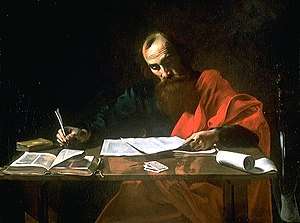
Hebrew Bible
| Tanakh | ||||||||||||||||||||||||||||
|---|---|---|---|---|---|---|---|---|---|---|---|---|---|---|---|---|---|---|---|---|---|---|---|---|---|---|---|---|
 | ||||||||||||||||||||||||||||
|
||||||||||||||||||||||||||||
|
||||||||||||||||||||||||||||
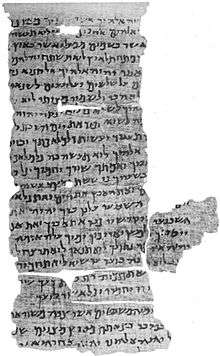
The Masoretic Text is the authoritative Hebrew text of the Hebrew Bible. It defines the books of the Jewish canon, and also the precise letter-text of these biblical books, with their vocalization and accentuation.
The oldest extant manuscripts of the Masoretic Text date from approximately the 9th century CE,[25] and the Aleppo Codex (once the oldest complete copy of the Masoretic Text, but now missing its Torah section) dates from the 10th century. The term "Keter" (crown, from the Arabic, taj) originally referred to this particular manuscript, Over the years, the term Keter came to refer to any full text of the Hebrew Bible, or significant portion of it, bound as a codex (not a scroll) and including vowel points, cantillation marks, and Masoretic notes. Medieval handwritten manuscripts were considered extremely precise, the most authoritative documents from which to copy other texts.[26]
The name Tanakh (Hebrew: תנ"ך) reflects the threefold division of the Hebrew Scriptures, Torah ("Teaching"), Nevi'im ("Prophets") and Ketuvim ("Writings").
Torah
The Torah (תּוֹרָה) is also known as the "Five Books of Moses" or the Pentateuch, meaning "five scroll-cases".[27] Traditionally these books were considered to have been written almost entirely by Moses himself.[28] In the 19th century, Julius Wellhausen and other scholars proposed that the Torah had been compiled from earlier written documents dating from the 9th to the 5th century BCE, the "documentary hypothesis".[28] Scholars Hermann Gunkel and Martin Noth, building on the form criticism of Gerhard von Rad, refined this hypothesis, while other scholars have proposed other ways that the Torah might have developed over the centuries.[28]

The Hebrew names of the books are derived from the first words in the respective texts. The Torah consists of the following five books:
- Genesis, Beresheeth (בראשית)
- Exodus, Shemot (שמות)
- Leviticus, Vayikra (ויקרא)
- Numbers, Bamidbar (במדבר)
- Deuteronomy, Devarim (דברים)
The first eleven chapters of Genesis provide accounts of the creation (or ordering) of the world and the history of God's early relationship with humanity. The remaining thirty-nine chapters of Genesis provide an account of God's covenant with the biblical patriarchs Abraham, Isaac and Jacob (also called Israel) and Jacob's children, the "Children of Israel", especially Joseph. It tells of how God commanded Abraham to leave his family and home in the city of Ur, eventually to settle in the land of Canaan, and how the Children of Israel later moved to Egypt. The remaining four books of the Torah tell the story of Moses, who lived hundreds of years after the patriarchs. He leads the Children of Israel from slavery in ancient Egypt to the renewal of their covenant with God at biblical Mount Sinai and their wanderings in the desert until a new generation was ready to enter the land of Canaan. The Torah ends with the death of Moses.[29]
The commandments in the Torah provide the basis for Jewish religious law. Tradition states that there are 613 commandments (taryag mitzvot).
Nevi'im
| Books of Nevi'im |
|---|
| Former Prophets |
| Latter Prophets (major) |
| Latter Prophets (Twelve minor) |
| Hebrew Bible |
Nevi'im (Hebrew: נְבִיאִים, romanized: Nəḇî'îm, "Prophets") is the second main division of the Tanakh, between the Torah and Ketuvim. It contains two sub-groups, the Former Prophets (Nevi'im Rishonim נביאים ראשונים, the narrative books of Joshua, Judges, Samuel and Kings) and the Latter Prophets (Nevi'im Aharonim נביאים אחרונים, the books of Isaiah, Jeremiah and Ezekiel and the Twelve Minor Prophets).
The Nevi'im tell the story of the rise of the Hebrew monarchy and its division into two kingdoms, ancient Israel and Judah, focusing on conflicts between the Israelites and other nations, and conflicts among Israelites, specifically, struggles between believers in "the LORD God"[30] (Yahweh) and believers in foreign gods,[31][32] and the criticism of unethical and unjust behaviour of Israelite elites and rulers;[33][34][35] in which prophets played a crucial and leading role. It ends with the conquest of the Kingdom of Israel by the Assyrians followed by the conquest of the Kingdom of Judah by the Babylonians and the destruction of the Temple in Jerusalem.
Former Prophets
The Former Prophets are the books Joshua, Judges, Samuel and Kings. They contain narratives that begin immediately after the death of Moses with the divine appointment of Joshua as his successor, who then leads the people of Israel into the Promised Land, and end with the release from imprisonment of the last king of Judah. Treating Samuel and Kings as single books, they cover:
- Joshua's conquest of the land of Canaan (in the Book of Joshua),
- the struggle of the people to possess the land (in the Book of Judges),
- the people's request to God to give them a king so that they can occupy the land in the face of their enemies (in the Books of Samuel)
- the possession of the land under the divinely appointed kings of the House of David, ending in conquest and foreign exile (Books of Kings)
Latter Prophets
The Latter Prophets are divided into two groups, the "major" prophets, Isaiah, Jeremiah, Ezekiel, Daniel, and the Twelve Minor Prophets, collected into a single book. The collection is broken up to form twelve individual books in the Christian Old Testament, one for each of the prophets:
Ketuvim
| Books of the Ketuvim |
|---|
| Three poetic books |
| Five Megillot (Scrolls) |
| Other books |
| Hebrew Bible |
Ketuvim or Kəṯûḇîm (in Biblical Hebrew: כְּתוּבִים "writings") is the third and final section of the Tanakh. The Ketuvim are believed to have been written under the Ruach HaKodesh (the Holy Spirit) but with one level less authority than that of prophecy.[36]
The poetic books
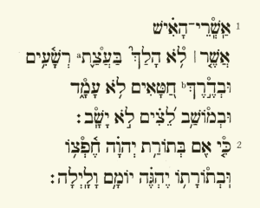
In Masoretic manuscripts (and some printed editions), Psalms, Proverbs and Job are presented in a special two-column form emphasizing the parallel stichs in the verses, which are a function of their poetry. Collectively, these three books are known as Sifrei Emet (an acronym of the titles in Hebrew, איוב, משלי, תהלים yields Emet אמ"ת, which is also the Hebrew for "truth").
These three books are also the only ones in Tanakh with a special system of cantillation notes that are designed to emphasize parallel stichs within verses. However, the beginning and end of the book of Job are in the normal prose system.
The five scrolls (Hamesh Megillot)
The five relatively short books of Song of Songs, Book of Ruth, the Book of Lamentations, Ecclesiastes and Book of Esther are collectively known as the Hamesh Megillot (Five Megillot). These are the latest books collected and designated as "authoritative" in the Jewish canon even though they were not complete until the 2nd century CE.[37]
Other books
Besides the three poetic books and the five scrolls, the remaining books in Ketuvim are Daniel, Ezra–Nehemiah and Chronicles. Although there is no formal grouping for these books in the Jewish tradition, they nevertheless share a number of distinguishing characteristics:
- Their narratives all openly describe relatively late events (i.e., the Babylonian captivity and the subsequent restoration of Zion).
- The Talmudic tradition ascribes late authorship to all of them.
- Two of them (Daniel and Ezra) are the only books in the Tanakh with significant portions in Aramaic.
Order of the books
The following list presents the books of Ketuvim in the order they appear in most printed editions. It also divides them into three subgroups based on the distinctiveness of Sifrei Emet and Hamesh Megillot.
The Three Poetic Books (Sifrei Emet)
- Tehillim (Psalms) תְהִלִּים
- Mishlei (Book of Proverbs) מִשְלֵי
- Iyyôbh (Book of Job) אִיּוֹב
The Five Megillot (Hamesh Megillot)
- Shīr Hashshīrīm (Song of Songs) or (Song of Solomon) שִׁיר הַשׁשִׁירִים (Passover)
- Rūth (Book of Ruth) רוּת (Shābhû‘ôth)
- Eikhah (Lamentations) איכה (Ninth of Av) [Also called Kinnot in Hebrew.]
- Qōheleth (Ecclesiastes) קהלת (Sukkôth)
- Estēr (Book of Esther) אֶסְתֵר (Pûrîm)
Other books
- Dānî’ēl (Book of Daniel) דָּנִיֵּאל
- ‘Ezrā (Book of Ezra–Book of Nehemiah) עזרא
- Divrei ha-Yamim (Chronicles) דברי הימים
The Jewish textual tradition never finalized the order of the books in Ketuvim. The Babylonian Talmud (Bava Batra 14b–15a) gives their order as Ruth, Psalms, Job, Proverbs, Ecclesiastes, Song of Solomon, Lamentations of Jeremiah, Daniel, Scroll of Esther, Ezra, Chronicles.[38]
In Tiberian Masoretic codices, including the Aleppo Codex and the Leningrad Codex, and often in old Spanish manuscripts as well, the order is Chronicles, Psalms, Job, Proverbs, Ruth, Song of Solomon, Ecclesiastes, Lamentations of Jeremiah, Esther, Daniel, Ezra.[39]
Canonization
The Ketuvim is the last of the three portions of the Tanakh to have been accepted as biblical canon. While the Torah may have been considered canon by Israel as early as the 5th century BCE and the Former and Latter Prophets were canonized by the 2nd century BCE, the Ketuvim was not a fixed canon until the 2nd century of the Common Era.[37]
Evidence suggests, however, that the people of Israel were adding what would become the Ketuvim to their holy literature shortly after the canonization of the prophets. As early as 132 BCE references suggest that the Ketuvim was starting to take shape, although it lacked a formal title.[40] References in the four Gospels as well as other books of the New Testament indicate that many of these texts were both commonly known and counted as having some degree of religious authority early in the 1st century CE.
Many scholars believe that the limits of the Ketuvim as canonized scripture were determined by the Council of Jamnia c. 90 CE. Against Apion, the writing of Josephus in 95 CE, treated the text of the Hebrew Bible as a closed canon to which "... no one has ventured either to add, or to remove, or to alter a syllable..."[41] For a long time following this date the divine inspiration of Esther, the Song of Songs, and Ecclesiastes was often under scrutiny.[42]
Original languages
The Tanakh was mainly written in biblical Hebrew, with some small portions (Ezra 4:8–6:18 and 7:12–26, Jeremiah 10:11, Daniel 2:4–7:28) written in biblical Aramaic, a sister language which became the lingua franca for much of the Semitic world.[43]
Samaritan Pentateuch
Samaritans include only the Pentateuch in their biblical canon.[44] They do not recognize divine authorship or inspiration in any other book in the Jewish Tanakh.[45] A Samaritan Book of Joshua partly based upon the Tanakh's Book of Joshua exists, but Samaritans regard it as a non-canonical secular historical chronicle.[46]
Septuagint
The Septuagint, or the LXX, is a translation of the Hebrew Scriptures and some related texts into Koine Greek, begun in the late 3rd century BCE and completed by 132 BCE,[47][48][49] initially in Alexandria, but in time it was completed elsewhere as well.[50] It is not altogether clear which was translated when, or where; some may even have been translated twice, into different versions, and then revised.[51]
As the work of translation progressed, the canon of the Septuagint expanded. The Torah always maintained its pre-eminence as the basis of the canon but the collection of prophetic writings, based on the Nevi'im, had various hagiographical works incorporated into it. In addition, some newer books were included in the Septuagint, among these are the Maccabees and the Wisdom of Sirach. However, the book of Sirach, is now known to have existed in a Hebrew version, since ancient Hebrew manuscripts of it were rediscovered in modern times. The Septuagint version of some Biblical books, like Daniel and Esther, are longer than those in the Jewish canon.[52] Some of these deuterocanonical books (e.g. the Wisdom of Solomon, and the second book of Maccabees) were not translated, but composed directly in Greek.
Since Late Antiquity, once attributed to a hypothetical late 1st-century Council of Jamnia, mainstream Rabbinic Judaism rejected the Septuagint as valid Jewish scriptural texts. Several reasons have been given for this. First, some mistranslations were claimed. Second, the Hebrew source texts used for the Septuagint differed from the Masoretic tradition of Hebrew texts, which was chosen as canonical by the Jewish rabbis.[53] Third, the rabbis wanted to distinguish their tradition from the newly emerging tradition of Christianity.[49][54] Finally, the rabbis claimed a divine authority for the Hebrew language, in contrast to Aramaic or Greek – even though these languages were the lingua franca of Jews during this period (and Aramaic would eventually be given a holy language status comparable to Hebrew).[55]
The Septuagint is the basis for the Old Latin, Slavonic, Syriac, Old Armenian, Old Georgian and Coptic versions of the Christian Old Testament.[56] The Roman Catholic and Eastern Orthodox Churches use most of the books of the Septuagint, while Protestant churches usually do not. After the Protestant Reformation, many Protestant Bibles began to follow the Jewish canon and exclude the additional texts, which came to be called biblical apocrypha. The Apocrypha are included under a separate heading in the King James Version of the Bible, the basis for the Revised Standard Version.[57]
Incorporations from Theodotion
In most ancient copies of the Bible which contain the Septuagint version of the Old Testament, the Book of Daniel is not the original Septuagint version, but instead is a copy of Theodotion's translation from the Hebrew, which more closely resembles the Masoretic Text. The original Septuagint version was discarded in favour of Theodotion's version in the 2nd to 3rd centuries CE. In Greek-speaking areas, this happened near the end of the 2nd century, and in Latin-speaking areas (at least in North Africa), it occurred in the middle of the 3rd century. History does not record the reason for this, and St. Jerome reports, in the preface to the Vulgate version of Daniel, "This thing 'just' happened."[58] One of two Old Greek texts of the Book of Daniel has been recently rediscovered and work is ongoing in reconstructing the original form of the book.[59]
The canonical Ezra–Nehemiah is known in the Septuagint as "Esdras B", and 1 Esdras is "Esdras A". 1 Esdras is a very similar text to the books of Ezra–Nehemiah, and the two are widely thought by scholars to be derived from the same original text. It has been proposed, and is thought highly likely by scholars, that "Esdras B" – the canonical Ezra–Nehemiah – is Theodotion's version of this material, and "Esdras A" is the version which was previously in the Septuagint on its own.[58]
Final form
Some texts are found in the Septuagint but are not present in the Hebrew. These additional books are Tobit, Judith, Wisdom of Solomon, Wisdom of Jesus son of Sirach, Baruch, the Letter of Jeremiah (which later became chapter 6 of Baruch in the Vulgate), additions to Daniel (The Prayer of Azarias, the Song of the Three Children, Susanna and Bel and the Dragon), additions to Esther, 1 Maccabees, 2 Maccabees, 3 Maccabees, 4 Maccabees, 1 Esdras, Odes, including the Prayer of Manasseh, the Psalms of Solomon, and Psalm 151.
Some books that are set apart in the Masoretic Text are grouped together. For example, the Books of Samuel and the Books of Kings are in the LXX one book in four parts called Βασιλειῶν ("Of Reigns"). In LXX, the Books of Chronicles supplement Reigns and it is called Paralipomenon (Παραλειπομένων – things left out). The Septuagint organizes the minor prophets as twelve parts of one Book of Twelve.[59]
| The Orthodox Old Testament[50][60][lower-alpha 2] |
Greek-based name |
Conventional English name |
| Law | ||
|---|---|---|
| Γένεσις | Génesis | Genesis |
| Ἔξοδος | Éxodos | Exodus |
| Λευϊτικόν | Leuitikón | Leviticus |
| Ἀριθμοί | Arithmoí | Numbers |
| Δευτερονόμιον | Deuteronómion | Deuteronomy |
| History | ||
| Ἰησοῦς Nαυῆ | Iêsous Nauê | Joshua |
| Κριταί | Kritaí | Judges |
| Ῥούθ | Roúth | Ruth |
| Βασιλειῶν Αʹ[lower-alpha 3] | I Reigns | I Samuel |
| Βασιλειῶν Βʹ | II Reigns | II Samuel |
| Βασιλειῶν Γʹ | III Reigns | I Kings |
| Βασιλειῶν Δʹ | IV Reigns | II Kings |
| Παραλειπομένων Αʹ | I Paralipomenon[lower-alpha 4] | I Chronicles |
| Παραλειπομένων Βʹ | II Paralipomenon | II Chronicles |
| Ἔσδρας Αʹ | I Esdras | 1 Esdras |
| Ἔσδρας Βʹ | II Esdras | Ezra–Nehemiah |
| Τωβίτ[lower-alpha 5] | Tobit | Tobit or Tobias |
| Ἰουδίθ | Ioudith | Judith |
| Ἐσθήρ | Esther | Esther with additions |
| Μακκαβαίων Αʹ | I Makkabaioi | 1 Maccabees |
| Μακκαβαίων Βʹ | II Makkabaioi | 2 Maccabees |
| Μακκαβαίων Γʹ | III Makkabaioi | 3 Maccabees |
| Wisdom | ||
| Ψαλμοί | Psalms | Psalms |
| Ψαλμός ΡΝΑʹ | Psalm 151 | Psalm 151 |
| Προσευχὴ Μανάσση | Prayer of Manasseh | Prayer of Manasseh |
| Ἰώβ | Iōb | Job |
| Παροιμίαι | Proverbs | Proverbs |
| Ἐκκλησιαστής | Ekklesiastes | Ecclesiastes |
| Ἆσμα Ἀσμάτων | Song of Songs | Song of Solomon or Canticles |
| Σοφία Σαλoμῶντος | Wisdom of Solomon | Wisdom |
| Σοφία Ἰησοῦ Σειράχ | Wisdom of Jesus the son of Seirach | Sirach or Ecclesiasticus |
| Ψαλμοί Σαλoμῶντος | Psalms of Solomon | Psalms of Solomon[61] |
| Prophets | ||
| Δώδεκα | The Twelve | Minor Prophets |
| Ὡσηέ Αʹ | I. Osëe | Hosea |
| Ἀμώς Βʹ | II. Amōs | Amos |
| Μιχαίας Γʹ | III. Michaias | Micah |
| Ἰωήλ Δʹ | IV. Ioël | Joel |
| Ὀβδίου Εʹ[lower-alpha 6] | V. Obdias | Obadiah |
| Ἰωνᾶς Ϛ' | VI. Ionas | Jonah |
| Ναούμ Ζʹ | VII. Naoum | Nahum |
| Ἀμβακούμ Ηʹ | VIII. Ambakum | Habakkuk |
| Σοφονίας Θʹ | IX. Sophonias | Zephaniah |
| Ἀγγαῖος Ιʹ | X. Angaios | Haggai |
| Ζαχαρίας ΙΑʹ | XI. Zacharias | Zachariah |
| Ἄγγελος ΙΒʹ | XII. Messenger | Malachi |
| Ἠσαΐας | Hesaias | Isaiah |
| Ἱερεμίας | Hieremias | Jeremiah |
| Βαρούχ | Baruch | Baruch |
| Θρῆνοι | Lamentations | Lamentations |
| Ἐπιστολή Ιερεμίου | Epistle of Jeremiah | Letter of Jeremiah |
| Ἰεζεκιήλ | Iezekiêl | Ezekiel |
| Δανιήλ | Daniêl | Daniel with additions |
| Appendix | ||
| Μακκαβαίων Δ' Παράρτημα | IV Makkabees | 4 Maccabees[lower-alpha 7] |
Christian Bibles
| Part of a series on |
| Christianity |
|---|
 |
|
|
|
|
|

A Christian Bible is a set of books that a Christian denomination regards as divinely inspired and thus constituting scripture. Although the Early Church primarily used the Septuagint or the Targums among Aramaic speakers, the apostles did not leave a defined set of new scriptures; instead the canon of the New Testament developed over time. Groups within Christianity include differing books as part of their sacred writings, most prominent among which are the biblical apocrypha or deuterocanonical books.
Significant versions of the Christian Bible in English include the Douay-Rheims Bible, the Authorized King James Version, the Revised Version, the American Standard Version, the Revised Standard Version, the New American Standard Version, the New King James Version, the New International Version, the New American Bible, and the English Standard Version.
Old Testament
The books which make up the Christian Old Testament differ between the Catholic (see Catholic Bible), Orthodox, and Protestant (see Protestant Bible) churches, with the Protestant movement accepting only those books contained in the Hebrew Bible, while Catholic and Orthodox traditions have wider canons. A few groups consider particular translations to be divinely inspired, notably the Greek Septuagint and the Aramaic Peshitta. The Old Testament consists of many distinct books produced over a period of centuries: The first five books – Genesis, Exodus, Leviticus, book of Numbers and Deuteronomy – reached their present form in the Persian period (538–332 BC), and their authors were the elite of exilic returnees who controlled the Temple at that time.[62] The books of Joshua, Judges, Samuel and Kings follow, forming a history of Israel from the Conquest of Canaan to the Siege of Jerusalem c. 587 BC.[63]
These history books make up around half the total content of the Old Testament. Of the remainder, the books of the various prophets – Isaiah, Jeremiah, Ezekiel, and the twelve "minor prophets" – were written between the 8th and 6th centuries BC, with the exceptions of Jonah and Daniel, which were written much later. The "wisdom" books – Job, Proverbs, Ecclesiastes, Psalms, Song of Solomon – have various dates: Proverbs possibly was completed by the Hellenistic time (332–198 BC), though containing much older material as well; Job completed by the 6th century BC; Ecclesiastes by the 3rd century BC.[64]
Apocryphal or deuterocanonical books
In Eastern Christianity, translations based on the Septuagint still prevail. The Septuagint was generally abandoned in favour of the 10th-century Masoretic Text as the basis for translations of the Old Testament into Western languages. Some modern Western translations since the 14th century make use of the Septuagint to clarify passages in the Masoretic Text, where the Septuagint may preserve a variant reading of the Hebrew text. They also sometimes adopt variants that appear in other texts, e.g., those discovered among the Dead Sea Scrolls.[65][66]
A number of books which are part of the Peshitta or the Greek Septuagint but are not found in the Hebrew Bible (i.e., among the protocanonical books) are often referred to as deuterocanonical books by Roman Catholics referring to a later secondary (i.e., deutero) canon, that canon as fixed definitively by the Council of Trent 1545–1563.[67][68] It includes 46 books for the Old Testament (45 if Jeremiah and Lamentations are counted as one) and 27 for the New.[69]
Most Protestants term these books as apocrypha. Modern Protestant traditions do not accept the deuterocanonical books as canonical, although Protestant Bibles included them in Apocrypha sections until the 1820s. However, Roman Catholic and Eastern Orthodox Churches include these books as part of their Old Testament.
The Roman Catholic Church recognizes:[70]
- Tobit
- Judith
- 1 Maccabees
- 2 Maccabees
- Wisdom
- Sirach (or Ecclesiasticus)
- Baruch
- The Letter of Jeremiah (Baruch Chapter 6)
- Greek Additions to Esther (Book of Esther, chapters 10:4–12:6)
- The Prayer of Azariah and Song of the Three Holy Children verses 1–68 (Book of Daniel, chapter 3, verses 24–90)
- Susanna (Book of Daniel, chapter 13)
- Bel and the Dragon (Book of Daniel, chapter 14)
In addition to those, the Greek and Russian Orthodox Churches recognize the following:
Russian and Georgian Orthodox Churches include:
- 2 Esdras i.e., Latin Esdras in the Russian and Georgian Bibles
There is also 4 Maccabees which is only accepted as canonical in the Georgian Church, but was included by St. Jerome in an appendix to the Vulgate, and is an appendix to the Greek Orthodox Bible, and it is therefore sometimes included in collections of the Apocrypha.
The Syriac Orthodox tradition includes:
- Psalms 151–155
- The Apocalypse of Baruch
- The Letter of Baruch
The Ethiopian Biblical canon includes:
and some other books.
The Anglican Church uses some of the Apocryphal books liturgically, though rarely and with alternative reading available. Therefore, editions of the Bible intended for use in the Anglican Church may include the Deuterocanonical books accepted by the Catholic Church, plus 1 Esdras, 2 Esdras and the Prayer of Manasseh, which were in the Vulgate appendix.[71]
Pseudepigraphal books
The term pseudepigrapha commonly describes numerous works of Jewish religious literature written from about 300 BCE to 300 CE. Not all of these works are actually pseudepigraphical. It also refers to books of the New Testament canon whose authorship is misrepresented. The Old Testament pseudepigraphal works include the following:[72]
- 3 Maccabees
- 4 Maccabees
- Assumption of Moses
- Ethiopic Book of Enoch (1 Enoch)
- Slavonic Book of Enoch (2 Enoch)
- Hebrew Book of Enoch (3 Enoch) (also known as "The Revelation of Metatron" or "The Book of Rabbi Ishmael the High Priest")
- Book of Jubilees
- Syriac Apocalypse of Baruch (2 Baruch)
- Letter of Aristeas (Letter to Philocrates regarding the translating of the Hebrew Scriptures into Greek)
- Life of Adam and Eve
- Martyrdom and Ascension of Isaiah
- Psalms of Solomon
- Sibylline Oracles
- Greek Apocalypse of Baruch (3 Baruch)
- Testaments of the Twelve Patriarchs
Book of Enoch
Notable pseudepigraphal works include the Books of Enoch (such as 1 Enoch, 2 Enoch, surviving only in Old Slavonic, and 3 Enoch, surviving in Hebrew, c. 5th to 6th century CE). These are ancient Jewish religious works, traditionally ascribed to the prophet Enoch, the great-grandfather of the patriarch Noah. They are not part of the biblical canon used by Jews, apart from Beta Israel. Most Christian denominations and traditions may accept the Books of Enoch as having some historical or theological interest or significance. It has been observed that part of the Book of Enoch is quoted in the Epistle of Jude (part of the New Testament) but Christian denominations generally regard the Books of Enoch as non-canonical or non-inspired.[73] However, the Enoch books are treated as canonical by the Ethiopian Orthodox Tewahedo Church and Eritrean Orthodox Tewahedo Church.
The older sections (mainly in the Book of the Watchers) are estimated to date from about 300 BCE, and the latest part (Book of Parables) probably was composed at the end of the 1st century BCE.[74]
Denominational views of pseudepigrapha
There arose in some Protestant biblical scholarship an extended use of the term pseudepigrapha for works that appeared as though they ought to be part of the biblical canon, because of the authorship ascribed to them, but which stood outside both the biblical canons recognized by Protestants and Catholics. These works were also outside the particular set of books that Roman Catholics called deuterocanonical and to which Protestants had generally applied the term Apocryphal. Accordingly, the term pseudepigraphical, as now used often among both Protestants and Roman Catholics (allegedly for the clarity it brings to the discussion), may make it difficult to discuss questions of pseudepigraphical authorship of canonical books dispassionately with a lay audience. To confuse the matter further, Eastern Orthodox Christians accept books as canonical that Roman Catholics and most Protestant denominations consider pseudepigraphical or at best of much less authority. There exist also churches that reject some of the books that Roman Catholics, Orthodox and Protestants accept. The same is true of some Jewish sects. Many works that are apocryphal are otherwise considered genuine.
Role of the Old Testament in Christian theology
The Old Testament has always been central to the life of the Christian church. Bible scholar N.T. Wright says "Jesus himself was profoundly shaped by the scriptures."[75] He adds that the earliest Christians also searched those same Hebrew scriptures in their effort to understand the earthly life of Jesus. They regarded the "holy writings" of the Israelites as necessary and instructive for the Christian, as seen from Paul's words to Timothy (2 Timothy 3:15), and as pointing to the Messiah, and as having reached a climactic fulfilment in Jesus himself, generating the "new covenant" prophesied by Jeremiah.[76]
New Testament
The New Testament is the name given to the second and final portion of the Christian Bible. Jesus is its central figure.
The term "New Testament" came into use in the second century during a controversy among Christians over whether the Hebrew Bible should be included with the Christian writings as sacred scripture. The New Testament presupposes the inspiration of the Old Testament.[77] Some other works which were widely read by early churches were excluded from the New Testament and relegated to the collections known as the Apostolic Fathers (generally considered orthodox) and the New Testament Apocrypha (including both orthodox and heretical works).
The New Testament is a collection of 27 books[78] of 4 different genres of Christian literature (Gospels, one account of the Acts of the Apostles, Epistles and an Apocalypse). These books can be grouped into:
Narrative literature, account and history of the Apostolic age
Pauline Epistles
- First Epistle to Timothy
- Second Epistle to Timothy
- Epistle to Titus
- Epistle to Philemon
- Epistle to the Hebrews
General epistles, also called catholic epistles
- Epistle of James
- First Epistle of Peter
- Second Epistle of Peter
- First Epistle of John
- Second Epistle of John
- Third Epistle of John
- Epistle of Jude
Apocalyptic literature, also called Prophetical
- Revelation, or the Apocalypse
The New Testament books are ordered differently in the Catholic/Orthodox/Protestant tradition, the Slavonic tradition, the Syriac tradition and the Ethiopian tradition.
Original language
The mainstream consensus is that the New Testament was written in a form of Koine Greek,[79][80] which was the common language of the Eastern Mediterranean[81][82][83][84] from the Conquests of Alexander the Great (335–323 BCE) until the evolution of Byzantine Greek (c. 600).
Historic editions
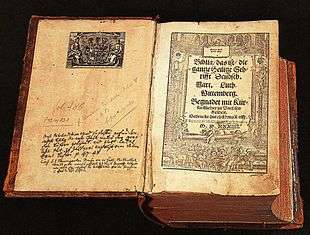
The original autographs, that is, the original Greek writings and manuscripts written by the original authors of the New Testament, have not survived.[85] But historically copies exist of those original autographs, transmitted and preserved in a number of manuscript traditions. There have been some minor variations, additions or omissions, in some of the texts. When ancient scribes copied earlier books, they sometimes wrote notes on the margins of the page (marginal glosses) to correct their text – especially if a scribe accidentally omitted a word or line – and to comment about the text. When later scribes were copying the copy, they were sometimes uncertain if a note was intended to be included as part of the text.
The three main textual traditions of the Greek New Testament are sometimes called the Alexandrian text-type (generally minimalist), the Byzantine text-type (generally maximalist), and the Western text-type (occasionally wild). Together they comprise most of the ancient manuscripts.
Development of the Christian canons
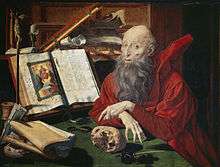
The Old Testament canon entered into Christian use in the Greek Septuagint translations and original books, and their differing lists of texts. In addition to the Septuagint, Christianity subsequently added various writings that would become the New Testament. Somewhat different lists of accepted works continued to develop in antiquity. In the 4th century a series of synods produced a list of texts equal to the 39, 46, 51, or 54-book canon of the Old Testament and to the 27-book canon of the New Testament that would be subsequently used to today, most notably the Synod of Hippo in 393 CE. Also c. 400, Jerome produced a definitive Latin edition of the Bible (see Vulgate), the canon of which, at the insistence of the Pope, was in accord with the earlier Synods. With the benefit of hindsight it can be said that this process effectively set the New Testament canon, although there are examples of other canonical lists in use after this time.
The Protestant Old Testament of today has a 39-book canon – the number of books (though not the content) varies from the Jewish Tanakh only because of a different method of division – while the Roman Catholic Church recognizes 46 books (51 books with some books combined into 46 books) as the canonical Old Testament. The Eastern Orthodox Churches recognize 3 Maccabees, 1 Esdras, Prayer of Manasseh and Psalm 151 in addition to the Catholic canon. Some include 2 Esdras. The Anglican Church also recognizes a longer canon. The term "Hebrew Scriptures" is often used as being synonymous with the Protestant Old Testament, since the surviving scriptures in Hebrew include only those books, while Catholics and Orthodox include additional texts that have not survived in Hebrew. Both Catholics and Protestants (as well as Greek Orthodox) have the same 27-book New Testament Canon.[86]
The New Testament writers assumed the inspiration of the Old Testament, probably earliest stated in 2 Timothy 3:16, "All scripture is given by inspiration of God".[11]
Ethiopian Orthodox canon
The Canon of the Ethiopian Orthodox Tewahedo Church is wider than the canons used by most other Christian churches. There are 81 books in the Ethiopian Orthodox Bible.[87] The Ethiopian Old Testament Canon includes the books found in the Septuagint accepted by other Orthodox Christians, in addition to Enoch and Jubilees which are ancient Jewish books that only survived in Ge'ez but are quoted in the New Testament, also Greek Ezra First and the Apocalypse of Ezra, 3 books of Meqabyan, and Psalm 151 at the end of the Psalter. The three books of Meqabyan are not to be confused with the books of Maccabees. The order of the other books is somewhat different from other groups', as well. The Old Testament follows the Septuagint order for the Minor Prophets rather than the Jewish order.
Divine inspiration
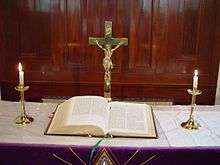
The Second Epistle to Timothy says that "all scripture is given by inspiration of God, and is profitable for doctrine, for reproof, for correction, for instruction in righteousness". (2 Timothy 3:16)[88] Various related but distinguishable views on divine inspiration include:
- the view of the Bible as the inspired word of God: the belief that God, through the Holy Spirit, intervened and influenced the words, message, and collation of the Bible[89]
- the view that the Bible is also infallible, and incapable of error in matters of faith and practice, but not necessarily in historic or scientific matters
- the view that the Bible represents the inerrant word of God, without error in any aspect, spoken by God and written down in its perfect form by humans
Within these broad beliefs many schools of hermeneutics operate. "Bible scholars claim that discussions about the Bible must be put into its context within church history and then into the context of contemporary culture."[76] Fundamentalist Christians are associated with the doctrine of biblical literalism, where the Bible is not only inerrant, but the meaning of the text is clear to the average reader.[90]
Jewish antiquity attests to belief in sacred texts,[91][92] and a similar belief emerges in the earliest of Christian writings. Various texts of the Bible mention divine agency in relation to its writings.[93] In their book A General Introduction to the Bible, Norman Geisler and William Nix write: "The process of inspiration is a mystery of the providence of God, but the result of this process is a verbal, plenary, inerrant, and authoritative record."[94] Most evangelical biblical scholars[95][96][97] associate inspiration with only the original text; for example some American Protestants adhere to the 1978 Chicago Statement on Biblical Inerrancy which asserted that inspiration applied only to the autographic text of Scripture.[98] Among adherents of Biblical literalism, a minority, such as followers of the King-James-Only Movement, extend the claim of inerrancy only to a particular version.[99]
Versions and translations
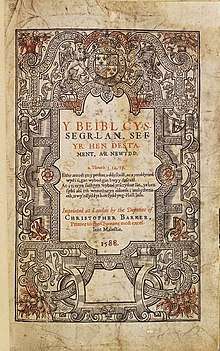
The original texts of the Tanakh were almost entirely written in Hebrew; about one per cent is written in Aramaic. In addition to the authoritative Masoretic Text, Jews still refer to the Septuagint, the translation of the Hebrew Bible into Greek, and the Targum Onkelos, an Aramaic version of the Bible. There are several different ancient versions of the Tanakh in Hebrew, mostly differing by spelling, and the traditional Jewish version is based on the version known as Aleppo Codex. Even in this version there are words which are traditionally read differently from written, because the oral tradition is considered more fundamental than the written one, and presumably mistakes had been made in copying the text over the generations.
The primary biblical text for early Christians was the Septuagint. In addition, they translated the Hebrew Bible into several other languages. Translations were made into Syriac, Coptic, Ethiopic, and Latin, among other languages. The Latin translations were historically the most important for the Church in the West, while the Greek-speaking East continued to use the Septuagint translations of the Old Testament and had no need to translate the New Testament.
The earliest Latin translation was the Old Latin text, or Vetus Latina, which, from internal evidence, seems to have been made by several authors over a period of time. It was based on the Septuagint, and thus included books not in the Hebrew Bible.
According to the Latin Decretum Gelasianum (also known as the Gelasian Decree), thought to be of a 6th-century document[100][101] of uncertain authorship and of pseudepigraphal papal authority (variously ascribed to Pope Gelasius I, Pope Damasus I, or Pope Hormisdas)[102][103][104] but reflecting the views of the Roman Church by that period,[105] the Council of Rome in 382 AD under Pope Damasus I (366–383) assembled a list of books of the Bible. Damasus commissioned Saint Jerome to produce a reliable and consistent text by translating the original Greek and Hebrew texts into Latin. This translation became known as the Latin Vulgate Bible, in the fourth century AD (although Jerome expressed in his prologues to most deuterocanonical books that they were non-canonical).[106][107] In 1546, at the Council of Trent, Jerome's Vulgate translation was declared by the Roman Catholic Church to be the only authentic and official Bible in the Latin Church.
Since the Protestant Reformation, Bible translations for many languages have been made. The Bible continues to be translated to new languages, largely by Christian organizations such as Wycliffe Bible Translators, New Tribes Mission and Bible societies.
| Number | Statistic |
|---|---|
| 7,353 | Approximate number of languages spoken in the world today |
| 2,617 | Number of translations into new languages in progress |
| 1,548 | Number of languages with a translation of the New Testament |
| 698 | Number of languages with a translation of the Bible (Protestant Canon) |
Views
John Riches, professor of Divinity and Biblical Criticism at the University of Glasgow, provides the following view of the diverse historical influences of the Bible:
It has inspired some of the great monuments of human thought, literature, and art; it has equally fuelled some of the worst excesses of human savagery, self-interest, and narrow-mindedness. It has inspired men and women to acts of great service and courage, to fight for liberation and human development; and it has provided the ideological fuel for societies which have enslaved their fellow human beings and reduced them to abject poverty. ... It has, perhaps above all, provided a source of religious and moral norms which have enabled communities to hold together, to care for, and to protect one another; yet precisely this strong sense of belonging has in turn fuelled ethnic, racial, and international tension and conflict.[109]
Other religions
In Islam, the Bible is held to reflect true unfolding revelation from God; but revelation which had been corrupted or distorted (in Arabic: tahrif); which necessitated the giving of the Qur'an to the Islamic prophet, Muhammad, to correct this deviation.
Members of other religions may also seek inspiration from the Bible. For example, Rastafaris view the Bible as essential to their religion[110] and Unitarian Universalists view it as "one of many important religious texts".[111]
Biblical studies
Biblical criticism refers to the investigation of the Bible as a text, and addresses questions such as authorship, dates of composition, and authorial intention. It is not the same as criticism of the Bible, which is an assertion against the Bible being a source of information or ethical guidance, or observations that the Bible may have translation errors.[112]
Higher criticism
In the 17th century Thomas Hobbes collected the current evidence to conclude outright that Moses could not have written the bulk of the Torah. Shortly afterwards the philosopher Baruch Spinoza published a unified critical analysis, arguing that the problematic passages were not isolated cases that could be explained away one by one, but pervasive throughout the five books, concluding that it was "clearer than the sun at noon that the Pentateuch was not written by Moses ..."[113]
Archaeological and historical research
Biblical archaeology is the archaeology that relates to and sheds light upon the Hebrew Scriptures and the Christian Greek Scriptures (or the New Testament). It is used to help determine the lifestyle and practices of people living in biblical times. There are a wide range of interpretations in the field of biblical archaeology. One broad division includes biblical maximalism which generally takes the view that most of the Old Testament or the Hebrew Bible is based on history although it is presented through the religious viewpoint of its time. It is considered to be the opposite of biblical minimalism which considers the Bible to be a purely post-exilic (5th century BCE and later) composition. Even among those scholars who adhere to biblical minimalism, the Bible is a historical document containing first-hand information on the Hellenistic and Roman eras, and there is universal scholarly consensus that the events of the 6th century BCE Babylonian captivity have a basis in history.
The historicity of the biblical account of the history of ancient Israel and Judah of the 10th to 7th centuries BCE is disputed in scholarship. The biblical account of the 8th to 7th centuries BCE is widely, but not universally, accepted as historical, while the verdict on the earliest period of the United Monarchy (10th century BCE) and the historicity of David is unclear. Archaeological evidence providing information on this period, such as the Tel Dan Stele, can potentially be decisive. The biblical account of events of the Exodus from Egypt in the Torah, and the migration to the Promised Land and the period of Judges are not considered historical in scholarship.[114][115]
Bible museums
- The Dunham Bible Museum is located in Houston, Texas. It is known for its collection of rare Bibles from around the world and for having many different Bibles of various languages.[116]
- The Museum of the Bible opened in Washington, D.C. in November 2017.[117] The museum states that its' intent is to "share the historical relevance and significance of the sacred scriptures in a nonsectarian way", but this has been questioned.[118][119]
- The Bible Museum in St Arnaud, Victoria, Australia opened in 2009.[120] As of 2020, it is closed for relocation.[121]
- There is a Bible Museum at The Great Passion Play in Eureka Springs, Arkansas.[122][123]
- The Bible Museum on the Square in Collierville, Tennessee opened in 1997.[124][125]
- Biedenharn Museum and Gardens in Monroe, Louisiana includes a Bible Museum.[126]
Image gallery
- Bibles
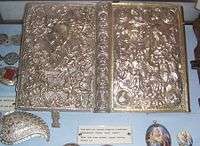 Old Bible from a Greek monastery
Old Bible from a Greek monastery Imperial Bible, or Vienna Coronation Gospels from Wien (Austria), c 1500.
Imperial Bible, or Vienna Coronation Gospels from Wien (Austria), c 1500.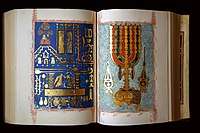 The Kennicott Bible, 1476
The Kennicott Bible, 1476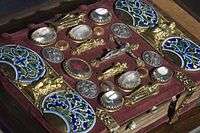 A Baroque Bible
A Baroque Bible The Bible used by Abraham Lincoln for his oath of office during his first inauguration in 1861
The Bible used by Abraham Lincoln for his oath of office during his first inauguration in 1861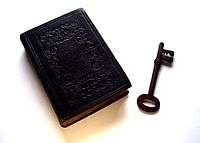 A miniature Bible
A miniature Bible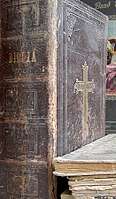 1866 Victorian Bible
1866 Victorian Bible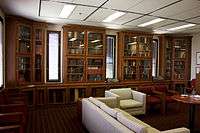 Shelves of the Bizzell Bible Collection at Bizzell Memorial Library
Shelves of the Bizzell Bible Collection at Bizzell Memorial Library.jpg) Detail of Leonardo da Vinci's Annunciation (c. 1472-1475) shows the Virgin Mary reading the Bible.
Detail of Leonardo da Vinci's Annunciation (c. 1472-1475) shows the Virgin Mary reading the Bible.
Illustrations
Most old Bibles were illuminated, they were manuscripts in which the text is supplemented by the addition of decoration, such as decorated initials, borders (marginalia) and miniature illustrations. Up to the twelfth century, most manuscripts were produced in monasteries in order to add to the library or after receiving a commission from a wealthy patron. Larger monasteries often contained separate areas for the monks who specialized in the production of manuscripts called a scriptorium, where "separate little rooms were assigned to book copying; they were situated in such a way that each scribe had to himself a window open to the cloister walk."[127] By the fourteenth century, the cloisters of monks writing in the scriptorium started to employ laybrothers from the urban scriptoria, especially in Paris, Rome and the Netherlands.[128] Demand for manuscripts grew to an extent that the Monastic libraries were unable to meet with the demand, and began employing secular scribes and illuminators.[129] These individuals often lived close to the monastery and, in certain instances, dressed as monks whenever they entered the monastery, but were allowed to leave at the end of the day.[130]
The manuscript was "sent to the rubricator, who added (in red or other colours) the titles, headlines, the initials of chapters and sections, the notes and so on; and then – if the book was to be illustrated – it was sent to the illuminator."[127] In the case of manuscripts that were sold commercially, the writing would "undoubtedly have been discussed initially between the patron and the scribe (or the scribe's agent,) but by the time that the written gathering were sent off to the illuminator there was no longer any scope for innovation."[131]
- Bible illustrations
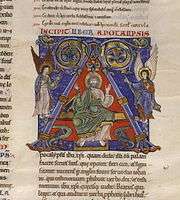 Bible from 1150, from Scriptorium de Chartres, Christ with angels
Bible from 1150, from Scriptorium de Chartres, Christ with angels Blanche of Castile and Louis IX of France Bible, 13th century
Blanche of Castile and Louis IX of France Bible, 13th century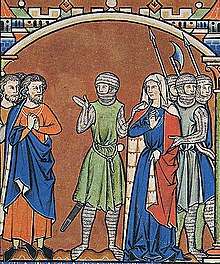
- Jephthah's daughter laments – Maciejowski Bible (France, ca. 1250)
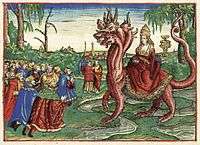 Coloured version of the Whore of Babylon illustration from Martin Luther's 1534 translation of the Bible
Coloured version of the Whore of Babylon illustration from Martin Luther's 1534 translation of the Bible An Armenian Bible, illuminated by Malnazar
An Armenian Bible, illuminated by Malnazar Fleeing Sodom and Gomorrah, Foster Bible
Fleeing Sodom and Gomorrah, Foster Bible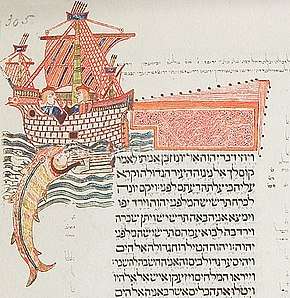 Jonah being swallowed by the fish, Kennicott Bible, 1476
Jonah being swallowed by the fish, Kennicott Bible, 1476
See also

- Bible box
- Bible case
- Bible paper
- Biblical software
- Code of Hammurabi
- Family Bible (book)
- International Bible Contest
- List of English Bible translations
- List of major biblical figures
- List of nations mentioned in the Bible
- Outline of Bible-related topics
- Scriptorium
- Theodicy and the Bible
- Typology – incorporating approaches to Biblical symbolism
Notes
- See also § Etymology.
- The canon of the original Old Greek LXX is disputed. This table reflects the canon of the Old Testament as used currently in Orthodoxy.
- Βασιλειῶν (Basileiōn) is the genitive plural of Βασιλεῖα (Basileia).
- That is, Things set aside from Ἔσδρας Αʹ.
- Also called Τωβείτ or Τωβίθ in some sources.
- Obdiou is genitive from "The vision of Obdias", which opens the book.
- Originally placed after 3 Maccabees and before Psalms, but placed in an appendix of the Orthodox Canon
References
- Miller & Huber, Stephen & Robert (2003). The Bible: the making and impact on the Bible a history. England: Lion Hudson. p. 21. ISBN 978-0-7459-5176-8.
- Riches 2000, pp. 7–8.
- "Methodist Beliefs: In what ways are Lutherans different from United Methodists?". Wisconsin Evangelical Lutheran Synod. 2014. Retrieved 22 May 2014.
The United Methodists see Scripture as the primary source and criterion for Christian doctrine. They emphasize the importance of tradition, experience, and reason for Christian doctrine. Lutherans teach that the Bible is the sole source for Christian doctrine. The truths of Scripture do not need to be authenticated by tradition, human experience, or reason. Scripture is self authenticating and is true in and of itself.
- Humphrey, Edith M. (15 April 2013). Scripture and Tradition. Baker Books. p. 16. ISBN 978-1-4412-4048-4.
historically Anglicans have adopted what could be called a prima Scriptura position.
- Biema, David (22 March 2007). "The Case For Teaching The Bible". Time Magazine. Retrieved 11 August 2018.
Simply put, the Bible is the most influential book of all-time... The Bible has done more to shape literature, history, entertainment, and culture than any book ever written. Its influence on world history is unparalleled, and shows no signs of abating. Even pop culture is deeply influenced by the Bible.
- "The Bible tops 'most influential' book survey". BBC. 13 November 2014. Retrieved 11 August 2018.
- "Best selling book of non-fiction". Guinness World Records. Retrieved 9 December 2015.
- Ryken, Leland. "How We Got the Best-Selling Book of All Time". The Wall Street Journal. Retrieved 9 December 2015.
- "The battle of the books". The Economist. 22 December 2007.
- Ash, Russell (2001). Top 10 of Everything 2002. Dorling Kindersley. ISBN 978-0-7894-8043-9.
- Stagg, Frank. New Testament Theology. Nashville: Broadman, 1962. ISBN 0-8054-1613-7.
- "From Hebrew Bible to Christian Bible" by Mark Hamilton on PBS's site From Jesus to Christ: The First Christians.
- Dictionary.com etymology of the word "Bible".
- Bruce 1988, p. 214.
- "The Catholic Encyclopedia". Newadvent.org. 1907. Retrieved 23 April 2010.
- Biblion, Henry George Liddell, Robert Scott, A Greek-English Lexicon, at Perseus.
- Bible Hub – The NT generally uses 1124 (graphḗ) for the Hebrew Scriptures (the OT) – but see also 2 Tim 3:16 and 2 Pet 3:16. 1124 (graphḗ) was used for the Hebrew Scriptures as early as Aristeas (about 130 bc; so MM)
- "Where did the chapter and verse numbers of the Bible originate?". CA. Archived from the original on 5 May 2012.
- Davies, Philip R. (2008). Memories of ancient Israel. Westminster John Knox Press. p. 7. ISBN 978-0-664-23288-7.
- Riches 2000, p. 83.
- Riches 2000, p. 9.
- Lim, Timothy H. (2005). The Dead Sea Scrolls: A Very Short Introduction. Oxford: Oxford University Press. p. 41.
- Riches 2000, p. 37.
- Riches 2000, pp. 23, 37
- A 7th-century fragment containing the Song of the Sea (Exodus 13:19–16:1) is one of the few surviving texts from the "silent era" of Hebrew biblical texts between the Dead Sea Scrolls and the Aleppo Codex. See "Rare scroll fragment to be unveiled," Jerusalem Post, May 21, 2007.
- "The Damascus Keters". National Library of Israel.
- The Restored New Testament: A New Translation with Commentary, Including the Gnostic Gospels Thomas, Mary, and Judas by Willis Barnstone – W. W. Norton & Company. p. 647
- "Pentateuch". Cross, F. L., ed. The Oxford dictionary of the Christian church. New York: Oxford University Press. 2005
- Seymour Rossel (2007). The Torah: Portion by Portion, p. 355. Torah Aura Productions, CA. Retrieved 31 August 2019.
- 1Kings.18:24;1Kings.18:37–39 9
- George Savran "I and II Kings" in The Literary Guide to the Bible edited by Robert Alter and Frank Kermode. "Each king is judged either good or bad in black-and-white terms, according to whether or not he "did right" or "did evil" in the sight of the Lord. This evaluation is not reflective of the well-being of the nation, of the king's success or failure in war, or of the moral climate of the times, but rather the state of cultic worship during his reign. Those kings who shun idolatry and enact religious reforms are singled out for praise, and those who encourage pagan practices are denounced." 146
- Yehezkel Kaufmann "Israel In Canaan" in Great Ages and Ideas of the Jewish People edited by Leo Schwartz, The Modern Library. "The fight against Baal was initiated by the prophets" 54
- Yehezkel Kaufmann "The Age of Prophecy" in Great Ages and Ideas of the Jewish People edited by Leo Schwartz, The Modern Library. "The immediate occasion of the rise of the new prophecy was the political and social ruin caused by the wars with Israel's northerly neighbor, Aram, which continued for more than a century. They raged intensely during the reign of Ahab, and did not end until the time of Jeroboam II (784–744). While the nation as a whole was impoverished, a few – apparently of the royal officialdom – grew wealthy as a result of the national calamity. Many of the people were compelled to sell their houses and lands, with the result that a sharp social cleavage arose: on the one hand a mass of propertyless indigents, on the other a small circle of the rich. A series of disasters struck the nation – drought, famine, plagues, death and captivity (Amos 4: 6–11), but the greatest disaster of all was the social disintegration due to the cleavage between the poor masses and the wealthy, dissolute upper class. The decay affected both Judah and Israel ... High minded men were appalled at this development. Was this the people whom YHWH had brought out of Egypt, to whom He had given the land and a law of justice and right? it seemed as if the land was about to be inherited by the rich, who would squander its substance in drunken revelry. it was this dissolution that brought the prophetic denunciations to white heat." 57–58
- Abraham Joshua Heschel 1955 The Prophets Harper and Row: "What manner of man is the prophet? A student of philosophy who runs from the discourses of the great metaphysicians to the orations of the prophets may feel as if he were going from the realm of the sublime to an area of trivialities. Instead of dealing with the timeless issues of being and becoming, of matter and form, of definitions and demonstrations, he is thrown into orations about widows and orphans, about the corruption of judges and affairs of the market place. Instead of showing us a way through the elegant mansions of the mind, the prophets take us to the slums. The world is a proud place, full of beauty, but the prophets are scandalized, and rave as if the whole world were a slum. They make much ado about paltry things, lavishing excessive language upon trifling subjects. What if somewhere in ancient Palestine poor people have not been treated properly by the rich? .... Indeed, the sorts of crimes and even the amount of delinquency that fill the prophets of Israel with dismay do not go beyond that which we regard as normal, as typical ingredients of social dynamics. To us a single act of injustice – cheating in business, exploitation of the poor – is slight; to the prophets, a disaster. To us an injustice is injurious to the welfare of the people; to the prophets it is a deathblow to existence; to us an episode; to them, a catastrophe, a threat to the world." 3–4
- Joel Rosenberg "I and II Samuel" in The Literary Guide to the Bible edited by Robert Alter and Frank Kermode. "Samuel is thus a work of national self-criticism. It recognizes that Israel would not have survived, either politically or culturally, without the steadying presence of a dynastic royal house. But it makes both that house and its subjects answerable to firm standards of prophetic justice – not those of cult prophets or professional ecstatics, but of morally upright prophetic leaders in the tradition of Moses, Joshua, Deborah, Gideon, and others ..." 141
- Neusner, Jacob, The Talmud Law, Theology, Narrative: A Sourcebook. University Press of America, 2005
- Coogan, Michael D. A Brief Introduction to the Old Testament: the Hebrew Bible in its Context. Oxford University Press. 2009; p. 5
- The Babylonian Talmud, Vol. 7 of 9: Tract Baba Bathra (Last Gate) translated by Michael L. Rodkinson, first published 1918 – published 2008 by Forgotten Books, p. 53
- Ketuvim כְּתוּבִים 30 July 2008
- Henshaw 1963, pp. 16–17.
- Lightfoot, Neil R. How We Got the Bible, 3rd edition, rev. and expanded. Baker Book House Company. 2003, pp. 154–55.
- Henshaw 1963, p. 17.
- Sir Godfrey Driver. "Introduction to the Old Testament of the New English Bible." Web: 30 November 2009
- Vanderkam 2002, p. 91.
- Although a paucity of extant source material makes it impossible to be certain that the earliest Samaritans also rejected the other books of the Tanakh, the third-century church father Origen confirms that the Samaritans in his day "receive[d] the books of Moses alone." (Commentary on John 13:26)
- Gaster, M. (1908). "A Samaritan Book of Joshua". The Living Age. 258: 166.
- Life after death: a history of the afterlife in the religions of the West (2004), Anchor Bible Reference Library, Alan F. Segal, p. 363
- Gilles Dorival, Marguerite Harl, and Olivier Munnich, La Bible grecque des Septante: Du judaïsme hellénistique au christianisme ancien (Paris: Cerfs, 1988), p. 111
- "[...] die griechische Bibelübersetzung, die einem innerjüdischen Bedürfnis entsprang [...] [von den] Rabbinen zuerst gerühmt (.) Später jedoch, als manche ungenaue Übertragung des hebräischen Textes in der Septuaginta und Übersetzungsfehler die Grundlage für hellenistische Irrlehren abgaben, lehte man die Septuaginta ab." Verband der Deutschen Juden (Hrsg.), neu hrsg. von Walter Homolka, Walter Jacob, Tovia Ben Chorin: Die Lehren des Judentums nach den Quellen; München, Knesebeck, 1999, Bd.3, S. 43ff
- Karen H. Jobes and Moises Silva (2001). Invitation to the Septuagint. Paternoster Press. ISBN 978-1-84227-061-5.
- Joel Kalvesmaki, The Septuagint
- Rick Grant Jones, Various Religious Topics, "Books of the Septuagint", (Accessed 2006.9.5).
- "The translation, which shows at times a peculiar ignorance of Hebrew usage, was evidently made from a codex which differed widely in places from the text crystallized by the Masorah." "Bible Translations – The Septuagint". JewishEncyclopedia.com. Retrieved 10 February 2012.
- "Two things, however, rendered the Septuagint unwelcome in the long run to the Jews. Its divergence from the accepted text (afterward called the Masoretic) was too evident; and it therefore could not serve as a basis for theological discussion or for homiletic interpretation. This distrust was accentuated by the fact that it had been adopted as Sacred Scripture by the new faith [Christianity] [...] In course of time it came to be the canonical Greek Bible [...] It became part of the Bible of the Christian Church.""Bible Translations – The Septuagint". JewishEncyclopedia.com. Retrieved 10 February 2012.
- Mishnah Sotah (7:2–4 and 8:1), among many others, discusses the sacredness of Hebrew, as opposed to Aramaic or Greek. This is comparable to the authority claimed for the original Arabic Koran according to Islamic teaching. As a result of this teaching, translations of the Torah into Koine Greek by early Jewish Rabbis have survived as rare fragments only.
- Ernst Würthwein, The Text of the Old Testament, trans. Errol F. Rhodes, Grand Rapids, Mich.: Wm. Eerdmans, 1995.
- "NETS: Electronic Edition". Ccat.sas.upenn.edu. 11 February 2011. Retrieved 13 August 2012.
- This article incorporates text from the 1903 Encyclopaedia Biblica article "Text and Versions", a publication now in the public domain.
- Jennifer M. Dines, The Septuagint, Michael A. Knibb, Ed., London: T&T Clark, 2004.
- Timothy McLay, The Use of the Septuagint in New Testament Research ISBN 0-8028-6091-5. – The current standard introduction on the NT & LXX.
- Not in Orthodox Canon, but originally included in the LXX. http://ccat.sas.upenn.edu/nets/edition/
- Barton, John (1998). The Cambridge companion to biblical interpretation. Barton, John, 1948– (1st ed.). Cambridge. ISBN 978-0-521-48144-1. OCLC 37353764.
- Eerdmans commentary on the Bible. Dunn, James D. G., 1939–, Rogerson, J. W. (John William), 1935–. Grand Rapids, MI: W.B. Eerdmans. 2003. ISBN 978-0-8028-3711-0. OCLC 53059839.CS1 maint: others (link)
- Crenshaw, James L. (2010). Old Testament wisdom : an introduction (3rd ed.). Louisville, Ky.: Westminster John Knox Press. ISBN 978-0-664-23459-1. OCLC 426147298.
- The Masoretic Text and the Dead Sea Scrolls – biblicalarchaeology.org. Retrieved 26 December 2012.
- "Dead Sea Scrolls" (PDF). Retrieved 6 June 2013.
- Council of Trent: Decretum de Canonicis Scripturis "Decree Concerning the Canonical Scriptures", from the Council's fourth session, of 4 April 1546: Canons and Decrees of the Council of Trent, The Fourth Session, Celebrated on the eighth day of the month of April, in the year 1546, English translation by James Waterworth (London 1848).
- The Council of Trent confirmed the identical list/canon of sacred scriptures already anciently approved by the Synod of Hippo (Synod of 393), Council of Carthage, 28 August 397, and Council of Florence (originally Council of Basel), Session 11, 4 February 1442 – [Bull of union with the Copts] seventh paragraph down.
- "Paragraph 120". Catechism of the Catholic Church, Second Edition. Libreria Editrice Vaticana. 2012. Retrieved 6 August 2014.
- Canon of Trent: List of the Canonical Scriptures.
But if anyone receive not, as sacred and canonical, the said books entire with all their parts, as they have been used to be read in the Catholic Church, and as they are contained in the old Latin vulgate edition; and knowingly and deliberately contemn the traditions aforesaid; let him be anathema.
— Decretum de Canonicis Scripturis, Council of Trent, 8 April 1546 - http://christopherbryanonline.com/the-canon-of-holy-scripture-an-anglican-note/
- Harris, Stephen L., Understanding the Bible. Palo Alto: Mayfield. 1985.
- The Book of Enoch – The Reluctant Messenger. Retrieved 14 June 2014.
- Fahlbusch E., Bromiley G.W. The Encyclopedia of Christianity: P–Sh p. 411, ISBN 0-8028-2416-1 (2004)
- Wright 2005, p. 3.
- Wright 2005
- Inspiration and Inerrancy: A History and a Defense, Henry Preserved Smith – R. Clarke, 1893, p. 343
- Mears, Henrietta C. (2007) "A glossary of Bible words". What the Bible is All About Visual Edition, pp. 438–439. Gospel Light Publications, CA. Retrieved 31 August 2019.
- Kurt Aland, Barbara Aland The text of the New Testament: an introduction to the critical 1995 p. 52 "The New Testament was written in Koine Greek, the Greek of daily conversation. The fact that from the first all the New Testament writings were written in Greek is conclusively demonstrated by their citations from the Old Testament ..."
- Archibald Macbride Hunter Introducing the New Testament 1972 p9 "How came the twenty-seven books of the New Testament to be gathered together and made authoritative Christian scripture? 1. All the New Testament books were originally written in Greek. On the face of it this may surprise us."
- Wenham The elements of New Testament Greek p. xxv Jeremy Duff, John William Wenham – 2005 "This is the language of the New Testament. By the time of Jesus the Romans had become the dominant military and political force, but the Greek language remained the 'common language' of the eastern Mediterranean and beyond, and Greek ..."
- Daniel B. Wallace Greek Grammar Beyond the Basics: An Exegetical Syntax of the New Testament 1997
- Henry St. John Thackeray Grammar of New Testament Greek ed. Friedrich Wilhelm Blass, 1911 "By far the most predominant element in the language of the New Testament is the Greek of common speech which was disseminated in the East by the Macedonian conquest, in the form which it had gradually assumed under the wider development ..."
- David E. Aune The Blackwell companion to the New Testament 2009 p.61 Chapter 4 New Testament Greek Christophe Rico "In this short overview of the Greek language of the New Testament we will focus on those topics that are of greatest importance for the average reader, that is, those with important ..."
- Manuscripts and the Text of the New Testament: An Introduction for English Readers by Keith Elliott, Ian Moir – Continuum International Publishing Group, 2000, p. 9
- Encyclopedia of Catholicism, Frank K. Flinn, Infobase Publishing, 1 January 2007, p. 103
- "The Ethiopian Orthodox Tewahedo Church". Ethiopianorthodox.org. Archived from the original on 5 November 2010. Retrieved 19 November 2010.
- Grudem, Wayne (1994). Systematic Theology. Leicester, England: Inter-Varsity Press. pp. 49–50.
- Rice, John R. – Our God-Breathed Book: The Bible – ISBN 0-87398-628-8, Sword of the Lord Publishers, 1969, pp 68–88.
- "Beyond Biblical Literalism and Inerrancy: Conservative Protestants and the Hermeneutic Interpretation of Scripture", John Bartkowski, Sociology of Religion, 57, 1996.
- Philo of Alexandria, De vita Moysis 3.23.
- Josephus, Contra Apion 1.8.
- "Basis for belief of Inspiration Biblegateway". Biblegateway.com. Retrieved 23 April 2010.
- Norman L. Geisler, William E. Nix. A General Introduction to the Bible. Moody Publishers, 1986, p. 86. ISBN 0-8024-2916-5
- For example, see Leroy Zuck, Roy B. Zuck. Basic Bible Interpretation. Chariot Victor Pub, 1991, p. 68. ISBN 0-89693-819-0
- Roy B. Zuck, Donald Campbell. Basic Bible Interpretation. Victor, 2002. ISBN 0-7814-3877-2
- Norman L. Geisler. Inerrancy. Zondervan, 1980, p. 294. ISBN 0-310-39281-0
- International Council on Biblical Inerrancy (1978). "The Chicago Statement on Biblical Inerrancy" (PDF). International Council on Biblical Inerrancy. Archived from the original (PDF) on 13 April 2008. Cite journal requires
|journal=(help) - "Ruckman's belief in advanced revelations in the KJV". Retrieved 27 February 2014.
- Clark, Francis (1987). The Pseudo-Gregorian dialogues. Leiden: E.J. Brill. pp. 601–02. ISBN 978-9004077737. Retrieved 13 January 2017.
- Bruce 1988, p. 234.
- Frazier, Alison (2015). Essays in Renaissance Thought and Letters: In Honor of John Monfasani. Leiden, Netherlands: Brill. p. 465. ISBN 978-9004294479. Retrieved 13 January 2017.
- Burkitt (1913). "The Decretum Geladianum". Journal of Theological Studies. 14: 469–71. Retrieved 13 January 2017.
- Ellis, E. Earle (2003). The Old Testament in early Christianity : canon and interpretation in the light of modern research. Eugene, Oregon: Wipf & Stock. p. 26. ISBN 978-1-59244-256-0. Retrieved 13 January 2017.
- "The Christian canon". Encyclopædia Britannica, Inc. Encyclopædia Britannica, Inc. Retrieved 13 January 2017.
- Kelly, J. N. D. (1960). Early Christian Doctrines. San Francisco: Harper. p. 55.
- Prologues of Saint Jerome,Latin text
- "Scripture Access Statistics". Retrieved 16 June 2020.
- Riches 2000, p. 134.
- Becoming Rasta: Origins of Rastafari Identity in Jamaica. p. 171, Charles Price. 2009
- Unitarian Universalism. p. 42, Zondervan Publishing, 2009
- "Expondo Os Erros Da Sociedade Bíblica Internacional". Baptistlink.com. 2000. Archived from the original on 29 October 2002. Retrieved 13 January 2012.
- Ten More Amazing Discoveries By George Potter, Cedar Fort, 2005, p. 121
-
- Finkelstein, Israel; Silberman, Neil Asher (2001). The Bible Unearthed: Archaeology's New Vision of Ancient Israel and the Origin of Its Sacred Texts. New York: Simon & Schuster. ISBN 978-0-7432-2338-6.
- Dever, William (2003). Who Were the Early Israelites and Where Did They Come from?. Grand Rapids, Michigan: William B. Eerdmans Publishing Company. ISBN 978-0-8028-0975-9.
- Turner, Allan (31 August 2015). "Historic Bibles ?' even a naughty one ?' featured at Houston's Dunham Museum". Houston Chronicle. Retrieved 10 February 2020.
- "About Us". www.museumofthebible.org. Museum of the Bible. Retrieved 11 February 2020.
- "Museum of the Bible opens in Washington, D.C., with celebration amid cynicism". NBC News.
- "Questions swirl around Museum of the Bible before grand opening". NBC News. Retrieved 11 February 2020.
- "St Arnaud gets it own holy grail". The Herald and Weekly Times. 21 April 2015. Retrieved 11 February 2020.
- "Bible Museum Homepage | Features". www.thebiblemuseum.com.au. Retrieved 11 February 2020.
Australia's only Bible Museum has temporarily closed and is preparing to relocate. Our exciting new location will be announced on this website.
- "Great Passion Play has some interesting new sights that don't cost anything to see (051519)". KSNF/KODE - FourStatesHomepage.com. 17 May 2019. Retrieved 11 February 2020.
- The Christian travel planner. Thomas Nelson. p. 327. ISBN 9781401603748. Retrieved 11 February 2020.
- Jordan, Leah. "Shelby County awards $15,000 grant for Bible Museum in Collierville". WHBQ-TV. Retrieved 11 February 2020.
- "ABOUT". Bible Museum On The Square. Archived from the original on 13 February 2020. Retrieved 11 February 2020.
- Mary, Fonseca. Weekend Getaways in Louisiana. Pelican Publishing. p. 249. ISBN 978-1-4556-1398-4. Retrieved 11 February 2020.
- Putnam A.M., Geo. Haven. Books and Their Makers During The Middle Ages. Vol. 1. New York: Hillary House, 1962. Print.
- De Hamel 1992, p. 45.
- De Hamel 1992, p. 57.
- De Hamel 1992, p. 65.
- De Hamel 1992, p. 60.
Works cited
- Bruce, Frederick (1988). The Canon of Scripture. Downers Grove, Illinois: IVP Academic. p. 214. ISBN 978-0-8308-1258-5.CS1 maint: ref=harv (link)
- De Hamel, Christopher (1992). Medieval Craftsmen: Scribes and Illuminations. Buffalo: University of Toronto.CS1 maint: ref=harv (link)
- Henshaw, T. (1963). The Writings: The Third Division of the Old Testament Canon. George Allen & Unwin Ltd.CS1 maint: ref=harv (link)
- Riches, John (2000). The Bible: A Very Short Introduction. Oxford: Oxford University Press. ISBN 978-0-19-285343-1.CS1 maint: ref=harv (link)
- Wright, N.T. (2005). The Last Word: Scripture and the Authority of God – Getting Beyond the Bible Wars. HarperCollins. ISBN 978-0-06-087261-8.CS1 maint: ref=harv (link)
Further reading
- Anderson, Bernhard W. Understanding the Old Testament. ISBN 0-13-948399-3.
- Asimov, Isaac. Asimov's Guide to the Bible. New York: Avenel Books, 1981. ISBN 0-517-34582-X.
- Berlin, Adele, Marc Zvi Brettler and Michael Fishbane. The Jewish Study Bible. Oxford University Press, 2003. ISBN 0-19-529751-2.
- Bible, Authorized Version. The New Cambridge Paragraph Bible, with the Apocrypha, King James Version, ed. by David Norton. Cambridge, Eng.: Cambridge University Press, 2005. N.B.: This is a critically reconstructed text of the Authorized "King James" Bible with its entire contents (including all of its marginalia, fore-matter, the Apocrypha, etc.), as close to the original translators' intentions and wording as possible at the time of this edition, with spelling modernized according to current Commonwealth usage. ISBN 978-0-521-84386-7
- Brown, Raymond E., Joseph A. Fitzmyer, and Roland E. Murphy, eds. (1990). The New Jerome Biblical Commentary. New Jersey: Prentice Hall. ISBN 0-13-614934-0.
- Finkelstein, Israel; Silberman, Neil Asher (August 2002). "Review: "The Bible Unearthed": A Rejoinder". Bulletin of the American Schools of Oriental Research. 327 (1): 63–73. doi:10.2307/1357859. JSTOR 1357859.
- Herzog, Ze'ev (29 October 1999). "Deconstructing the walls of Jericho". Ha'aretz. Archived from the original on 21 December 2008.
- Dever, William G. (March–April 2007). "Losing Faith: Who Did and Who Didn't, How Scholarship Affects Scholars" (PDF). Biblical Archaeology Review. 33 (2): 54.
- Ehrman, Bart D. Misquoting Jesus: The Story Behind Who Changed the Bible and Why New York: HarperSanFrancisco, 2005. ISBN 0-06-073817-0.
- Head, Tom. The Absolute Beginner's Guide to the Bible. Indianapolis: Que Publishing, 2005. ISBN 0-7897-3419-2
- Hoffman, Joel M. In the Beginning: A Short History of the Hebrew Language. New York University Press, 2004. ISBN 0-8147-3690-4
- Hotchkiss, Gregory K. The Middle Way: Reflections on Scripture and Tradition, in series, Reformed Episcopal Pamphlets, no. 3. Media, Penn.: Reformed Episcopal Publication Society, 1985. 27 p. N.B.: Place of publication also given as Philadelphia, Penn.; the approach to the issue is from an evangelical Anglican (Reformed Episcopal Church) orientation. Without ISBN
- Lienhard, Joseph T. The Bible, The Church, and Authority. Collegeville, Minnesota: Liturgical Press, 1995.
- Lindsell, Harold. The Battle for the Bible. Zondervan Publishing House, 1978. ISBN 0-310-27681-0
- Masalha, Nur, The Bible and Zionism: Invented Traditions, Archaeology and Post-Colonialism in Palestine-Israel. London, Zed Books, 2007.
- McDonald, Lee M. and Sanders, James A., eds. The Canon Debate. Hendrickson Publishers (1 January 2002). 662p. ISBN 1-56563-517-5 ISBN 978-1565635173
- Miller, John W. The Origins of the Bible: Rethinking Canon History Mahwah, New Jersey: Paulist Press, 1994. ISBN 0-8091-3522-1.
- Roper, J.C., Bp., et al.. The Bible. Toronto: Musson Book Co., 1924. In series, "The Layman's Library of Practical Religion, Church of England in Canada", vol. 4. N.B.: Series statement given here in the more extended form of it on the book's front cover.
- Siku. The Manga Bible: From Genesis to Revelation. Galilee Trade (15 January 2008). 224p. ISBN 0-385-52431-5 ISBN 978-0385524315
- Taylor, Hawley O. "Mathematics and Prophecy." Modern Science and Christian Faith. Wheaton: Van Kampen, 1948, pp. 175–83.
- Wycliffe Bible Encyclopedia, s.vv. "Book of Ezekiel", p. 580 and "prophecy", p. 1410. Chicago: Moody Bible Press, 1986.
External links
| Wikimedia Commons has media related to Bible. |
| Wikiquote has quotations related to: The Bible |
| Wikiquote has quotations related to: Bible quotes about love |
| Wikisource has original text related to this article: |
- Trinity College Digital Collections images of complete manuscript of the Book of Kells.
- "The Bible collected news and commentary" The New York Times.
- "The Bible collected news and commentary" The Guardian.
- The British Library: Discovering Sacred Texts – Christianity
- The National Library of Israel - Over 15,000 scanned manuscripts of the Old Testament
_(The_S.S._Teacher's_Edition-The_Holy_Bible).jpg)